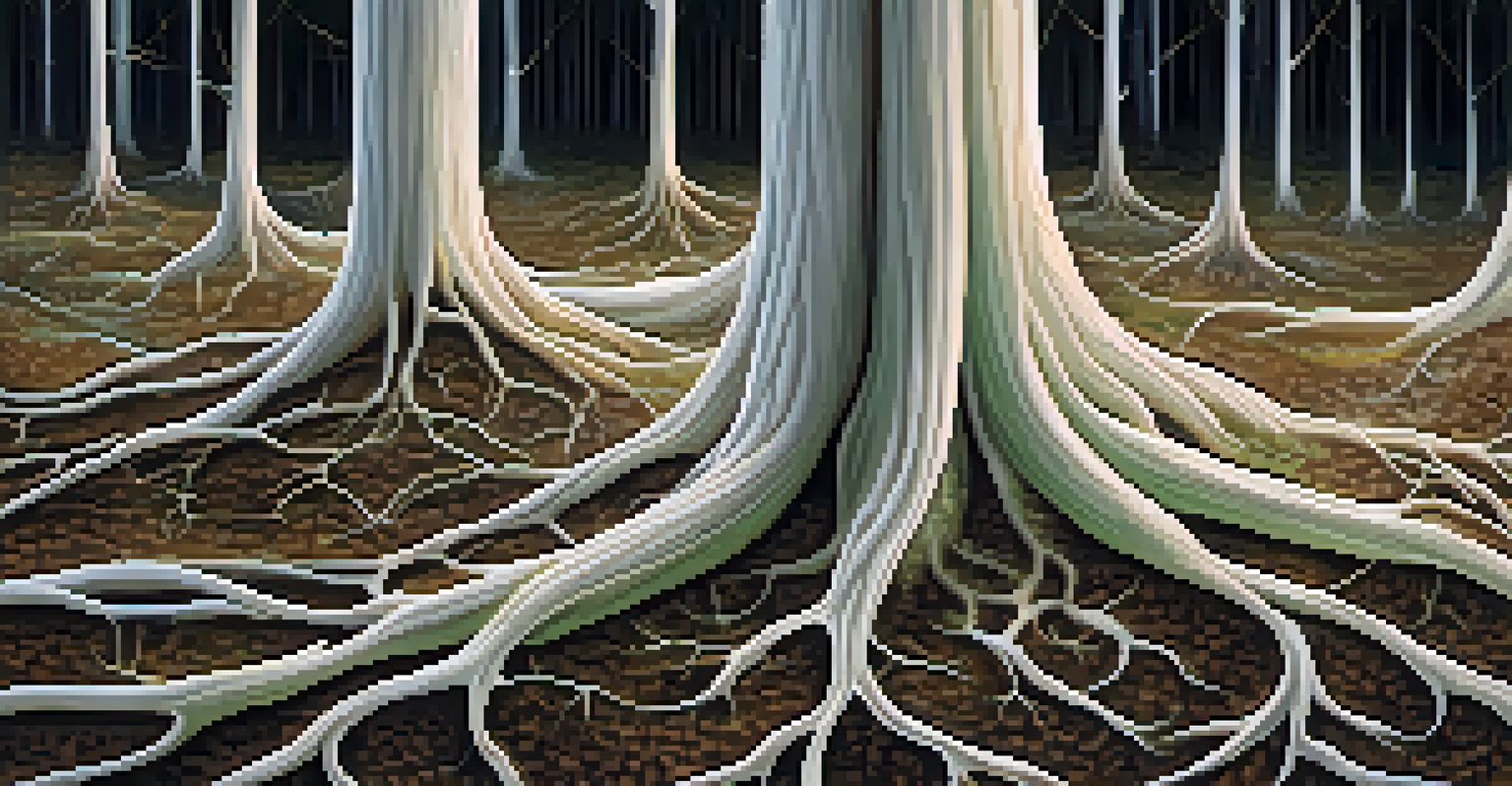The Role of Mycorrhizal Networks in Forest Ecosystems

What Are Mycorrhizal Networks and Their Importance?
Mycorrhizal networks are intricate webs formed by fungi that connect the roots of trees and plants. These networks resemble the internet of the forest, enabling communication and nutrient exchange between different species. Just like how we rely on connections to thrive, plants benefit immensely from these fungal partnerships.
The soil is the great connector of our lives, the source and destination of all. Food grows in it, and we are all nourished by it, directly or indirectly.
Through these connections, trees can share resources such as water, nitrogen, and carbon, particularly during stressful times like drought. This sharing not only enhances individual tree survival but also promotes the overall health of the forest ecosystem. It's a fantastic example of cooperation in nature, where the success of one can uplift many.
Additionally, mycorrhizal networks help in maintaining biodiversity within forest ecosystems. By facilitating interactions between different plant species, these networks can bolster resilience against diseases and pests, ensuring a balanced environment. This balance is crucial for the long-term sustainability of forests.
The Mechanism of Nutrient Exchange
At the heart of mycorrhizal networks lies a remarkable nutrient exchange system. Fungi extend their hyphae, which are thread-like structures, into the soil and absorb essential nutrients like phosphorus. In return, they trade these nutrients for carbohydrates produced by plants during photosynthesis, creating a win-win situation.

This relationship is particularly beneficial in nutrient-poor soils where traditional plant roots struggle to access vital minerals. By working together, plants and fungi can thrive in environments that would otherwise be challenging. It's akin to sharing a meal; when you have a friend with a full plate, you both enjoy a hearty feast.
Mycorrhizal Networks Enhance Survival
These fungal connections facilitate resource sharing among trees, improving their chances of survival during stressful conditions.
Moreover, this nutrient exchange promotes soil health by enhancing the microbial community within the ground. Healthier soils contribute to better water retention, which is essential for plant growth and overall ecosystem stability. Hence, the mycorrhizal networks play a pivotal role in enhancing not just individual plants, but the entire forest floor.
Facilitating Tree Communication
One of the most fascinating aspects of mycorrhizal networks is their ability to facilitate communication among trees. Through these fungal connections, trees can send chemical signals to one another, alerting neighboring plants about threats like pests or diseases. Imagine it as sending a text message to warn your friends of an incoming storm.
In nature, nothing exists alone.
This communication allows trees to prepare defenses, such as producing chemicals that deter pests or bolster their immune systems. In essence, mature trees can protect their younger counterparts, ensuring the survival of the next generation. It showcases a beautiful aspect of nature where wisdom and experience translate to communal care.
Additionally, this networked communication can even extend across species. Different tree species can share information and resources, fostering a diverse and resilient forest ecosystem. Just like a neighborhood watch program, these networks create a community of support and protection among various plant species.
Supporting Biodiversity and Ecosystem Stability
Mycorrhizal networks play a critical role in supporting biodiversity within forest ecosystems. By connecting different plant species, they help maintain a diverse array of flora, which is essential for a balanced ecosystem. Biodiversity ensures that various species can thrive under changing environmental conditions, much like a well-rounded diet supports our health.
Moreover, this diversity contributes to ecosystem stability. When one species faces a challenge, others can fill its role, preventing the entire system from collapsing. Just as a diverse team brings different strengths to a project, a variety of plant species enhances the resilience of the ecosystem.
Fungi Support Biodiversity and Stability
By linking different plant species, mycorrhizal networks promote biodiversity, which is essential for ecosystem resilience.
In this way, mycorrhizal networks act as a safety net, providing support and stability to the entire forest. They ensure that the ecosystem can withstand pressures such as climate change, invasive species, or natural disasters, making them vital for long-term forest health.
Impact on Carbon Sequestration
Another critical role of mycorrhizal networks is in carbon sequestration, a process essential for combating climate change. Through their interactions with plants, these networks aid in capturing carbon dioxide from the atmosphere and storing it in the soil. This process significantly contributes to reducing greenhouse gases.
Fungi help enhance the soil structure, which allows for increased carbon storage. When plants die and decompose, their carbon-rich biomass becomes part of the soil, promoting a long-term carbon sink. It’s like putting money in a savings account; the more you invest, the greater the return in the future.
Furthermore, healthy mycorrhizal networks can help restore degraded landscapes by promoting new plant growth. This regeneration not only enhances carbon sequestration but also fosters biodiversity and ecosystem resilience. It highlights how interconnected our actions are with the health of our planet.
Threats to Mycorrhizal Networks
Despite their vital role, mycorrhizal networks face significant threats, primarily from human activities. Deforestation, urbanization, and agricultural practices can disrupt these networks, leading to a decline in forest health. The loss of these fungal connections can severely impact nutrient exchange, tree communication, and overall biodiversity.
Moreover, the overuse of fertilizers can harm mycorrhizal fungi, disrupting the delicate balance of nutrient exchange. When synthetic fertilizers dominate, they can reduce the reliance on fungi, leading to weaker plant communities. It’s a bit like relying on takeout food; while convenient, it lacks the nutritional benefits of a balanced home-cooked meal.
Critical Role in Carbon Sequestration
Mycorrhizal networks help capture and store carbon dioxide in the soil, playing a vital role in combating climate change.
To protect these essential networks, it’s crucial to adopt sustainable land management practices. This includes reforestation efforts, reducing chemical inputs, and promoting organic farming. By taking these steps, we can help preserve the intricate mycorrhizal networks that support our forests.
The Future of Mycorrhizal Research
As our understanding of ecosystems deepens, the future of mycorrhizal research holds great promise. Scientists are increasingly recognizing the importance of these networks in forest health and resilience. Continued research can uncover new insights into how we can leverage these networks for ecosystem restoration and conservation.
Innovative studies are exploring the potential of mycorrhizal fungi in agricultural settings, promoting sustainable farming practices that benefit both crops and soil health. This could lead to a more harmonious relationship between agriculture and nature, ensuring food security while protecting our environmental resources.

Ultimately, fostering a deeper understanding of mycorrhizal networks can empower us to make informed decisions about land management and conservation. Just as we nurture our relationships with friends and family, we must also care for the networks that sustain our forests and the planet.